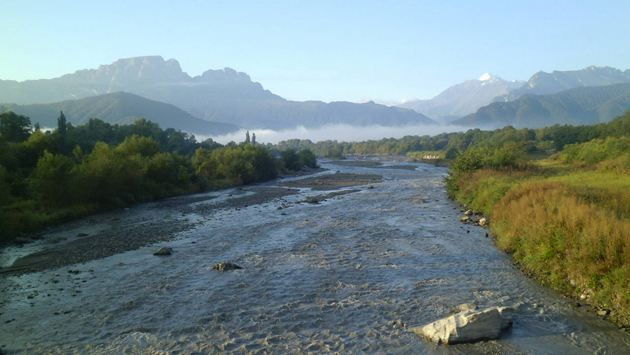Terek region
Terek region (Терщина; Tershchyna). A historical-geographic land located in eastern Subcaucasia, between the Kuban to the west, the Stavropol region to the northwest, Dagestan to the east, and the Caucasus Mountains to the south. In a specific sense the Terek region (about 30,000 sq km) was the land of the Terek Cossack Army, which was settled mostly by Russians and Ukrainians and constitutes one of the furthest reaches of the mixed Russian-Ukrainian ethnographic territory. In a broader sense the term refers to the entire former Terek oblast (72,900 sq km).
The southern part of the Terek region is occupied by the Caucasus Mountains. North of the mountains is a belt of steppe foothills, now almost completely plowed for crops. Beyond it is the semidesert Terek-Kuma Lowland. The mountains and a narrow portion of the adjoining foothills are settled by the Caucasian mountain peoples (the Chechens, the Ingushes, the Kabardians, and the Ossetes). The remaining part of the foothills and much of the Terek-Kuma Lowland are settled by Russians and Ukrainians. Some of the eastern parts of the Terek-Kuma Lowland are settled by the peoples of Dagestan (the Avars, the Dargins, the Nogays, and the Kumyks).
The colonization of the sparsely settled steppe portions of the Terek region by Slavs began at the end of the 15th century, when runaway serfs and frontier Don Cossacks from Riazan (Upper Don region) established themselves along the Terek River and formed the Grebensk Cossacks. The Cossacks, however, were unable to deal decisively with the local populations, and the region remained a battleground for hundreds of years. The ongoing struggle against the Caucasian mountain peoples finally ended in the 1860s with their subjugation. At the same time the emancipation of the serfs in the Russian Empire (1861) brought with it a flood of Slavic settlers to the sparsely settled region, most notably Ukrainians from Ukraine.
According to the census of 1897 Terek oblast had a population of 934,000. Its ethnic composition was as follows: 271,000 (29 percent) Russians, 42,000 (4.5 percent) Ukrainians, 375,000 (40.2 percent) Caucasian mountain peoples, 97,000 (10.4 percent) Ossetes, 98,000 (10.5 percent) Nogay Tatars, 12,000 (1.3 percent) Armenians, 9,000 (1 percent) Germans, and 30,000 (3.2 percent) others. Of the townships of Terek oblast Piatigorsk had the largest number of Ukrainians (25,000, or 13.8 percent). The assumption is that the census understated the number of Ukrainians because the Cossacks, who numbered 170,000 and made up 18.2 percent of the total population or 53 percent of all the ‘Russians’ in 1897, in fact included large numbers of Ukrainians. The population of the Terek region grew continuously and by 1916 had reached 1,360,000 (an increase of 46 percent over 1897), among whom there were 255,000 Cossacks (18.8 percent of the population).
The history of the Terek region in 1917–20 resembles that of the Don region and the Kuban region. Like the other two regions, the Terek expressed its desire for autonomy within a federated Russian republic and for close co-operation with the two other Cossack armies—the Don Cossacks and the Kuban Cossack Host. Late in 1917, following the October Revolution of 1917, the newly established governments of the Terek Cossack Army and the Union of the United Caucasian Mountain Peoples established a Terek-Dagestan government, with its seat in Vladikavkaz. As an opposing measure the Terek Soviet Republic within the Russian Soviet Federated Socialist Republic was established in March 1918. Ukrainians in the Terek region did not undertake any pro-Ukrainian political activity during the Ukrainian struggle for independence (1917–20).
The Soviet government split the Terek region into the predominantly Slavic Terek gubernia and the Mountain Peoples’ ASSR (which was subsequently subdivided into a number of autonomous oblasts and autonomous soviet socialist republics). During the period 1924–9 Terek gubernia was divided into Terek and Sunzha okrugs, which formed part of a much larger administrative unit known as the Northern Caucasian krai (Northern Caucasia). Terek as an administrative-territorial unit thereupon ceased to exist. The former Terek oblast now occupies the southern part of Stavropol krai and the following Autonomous Republics: Kabardino-Balkaria, North Ossetia, Checheno-Ingushetia, and the northern part of Dagestan.
The Soviet administrative structure precluded the calculation of precise numbers of Ukrainians in the Terek region as given by the post-Second World War censuses. An approximation by Ihor Stebelsky indicates 41,300 in 1970 and 43,100 in 1979 in the Autonomous Republics—about the same number as recorded for that part of the Terek region in 1926. Most of the Ukrainians now living in those areas, however, are urban and probably represent a subsequent immigration to assume administrative and industrial positions in the cities (rather than being the descendants of the earlier Ukrainian settlers). Of the 56,600 Ukrainians indicated by the 1979 census as living in Stavropol krai (53,500 in 1970), perhaps one-third (some 20,000) are concentrated in the Piatigorsk area, which was part of Terek oblast before 1920 and hence also part of the Terek region. Altogether some 60,000 Ukrainians, mostly newcomers, have been identified by the 1970 and 1979 censuses in the Terek region, only one-half the number counted in 1926.
BIBLIOGRAPHY
Fadeev, Anatolii. Ocherki ekonomicheskogo razvitiia stepnogo Predkavkaz'ia v doreformennyi period (Moscow 1957)
Severnyi Kavkaz (Moscow 1957)
Don i stepnoe Predkavkaz'e: XVIII–pervaia polovina XIX v., 2 vols (Rostov-na-Donu 1977)
Volodymyr Kubijovyč, Ihor Stebelsky
[This article originally appeared in the Encyclopedia of Ukraine, vol. 5 (1993).]
